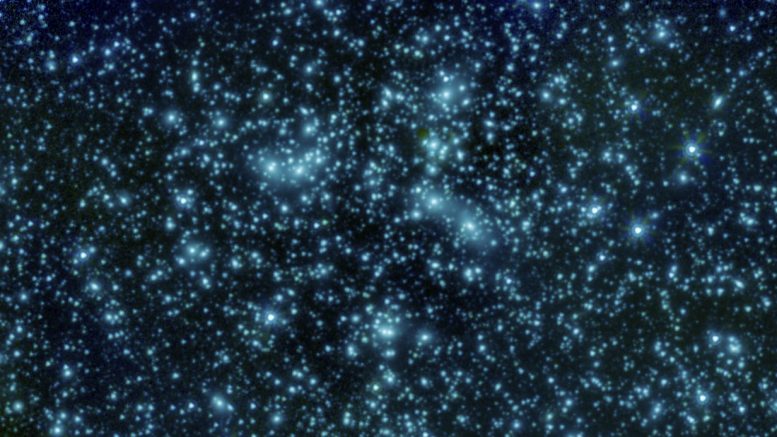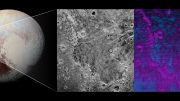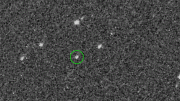
This image of galaxy cluster Abell 2744, also called Pandora’s Cluster, was taken by the Spitzer Space Telescope. The cluster is also being studied by NASA’s Hubble Space Telescope and Chandra X-Ray Observatory in a collaboration called the Frontier Fields project.
NASA’s Spitzer Space Telescope has finished its Frontier Fields observations and astronomers are working to get the data out to the astronomical community.
In the ongoing hunt for the universe’s earliest galaxies, NASA’s Spitzer Space Telescope has wrapped up its observations for the Frontier Fields project. This ambitious project has combined the power of all three of NASA’s Great Observatories — Spitzer, the Hubble Space Telescope, and the Chandra X-ray Observatory — to delve as far back in time and space as current technology can allow.
Even with today’s best telescopes, it is difficult to gather enough light from the very first galaxies, located more than 13 billion light years away, to learn much about them beyond their approximate distance. But scientists have a tool of cosmic proportions to help in their studies. The gravity exerted by massive, foreground clusters of galaxies bends and magnifies the light of faraway, background objects, in effect creating cosmic zoom lenses. This phenomenon is called gravitational lensing.
The Frontier Fields observations have peered through the strongest zoom lenses available by targeting six of the most massive galaxy clusters known. These lenses can magnify tiny background galaxies by as much as a factor of one hundred. With Spitzer’s new Frontier Fields data, along with data from Chandra and Hubble, astronomers will learn unprecedented details about the earliest galaxies.
“Spitzer has finished its Frontier Fields observations and we are very excited to get all of this data out to the astronomical community,” said Peter Capak, a research scientist with the NASA/JPL Spitzer Science Center at Caltech in Pasadena, California, and the Spitzer lead for the Frontier Fields project.
A recent paper published in the journal Astronomy & Astrophysics presented the full catalog data for two of the six galaxy clusters studied by the Frontier Fields: Abell 2744 — nicknamed Pandora’s Cluster — and MACS J0416, both located about four billion light years away. The other galaxy clusters selected for Frontier Fields are RXC J2248, MACS J1149, MACS J0717, and Abell 370.
Eager astronomers will comb the Frontier Fields catalogs for the tiniest, dimmest-lensed objects, many of which should prove to be the most distant galaxies ever glimpsed. The current record-holder, a galaxy called GN-z11, was reported in March by Hubble researchers at the astonishing distance of 13.4 billion light-years, only a few hundred million years after the Big Bang. The discovery of this galaxy did not require gravitational lenses because it is an outlying, extremely bright object for its epoch. With the magnification boost provided by gravitational lenses, the Frontier Fields project will allow researchers to study typical objects at such incredible distances, painting a more accurate and complete picture of the universe’s earliest galaxies.
Astronomers want to understand how these primeval galaxies arose, how their constituent mass developed into stars, and how these stars have enriched the galaxies with chemical elements fused in their thermonuclear furnaces. To learn about the origin and evolution of the earliest galaxies, which are quite faint, astronomers need to collect as much light as possible across a range of frequencies. With sufficient light from these galaxies, astronomers can perform spectroscopy, pulling out details about stars’ compositions, temperatures, and their environments by examining the signatures of chemical elements imprinted in the light.
“With the Frontier Fields approach,” said Capak, “the most remote and faintest galaxies are made bright enough for us to start to say some definite things about them, such as their star formation histories.”
Because the universe has expanded over its 13.8-billion-year history, light from extremely distant objects has been stretched out, or redshifted, on its long journey to Earth. Optical light emitted by stars in the gravitational-lensed, background galaxies viewed in the Frontier Fields has therefore redshifted into infrared. Spitzer can use this infrared light to gauge the population sizes of stars in a galaxy, which in turn gives clues to the galaxy’s mass. Combining the light seen by Spitzer and Hubble allows astronomers to identify galaxies at the edge of the observable universe.
Hubble, meanwhile, scans the Frontier Fields galaxy clusters in optical and near-infrared light, which has redshifted from ultraviolet light on its journey to Earth. Chandra, for its part, observes the foreground galaxy clusters in high-energy X-rays emitted by black holes and ambient hot gas. Along with Spitzer, the space telescopes size up the masses of the galaxy clusters, including their unseen but substantial dark matter content. Nailing down the clusters’ total mass is a critical step in quantifying the magnification and distortion they produce on background galaxies of interest. Recent multi-wavelength results in this vein from the Frontier Fields project regarding the MACS J0416 and MACS J0717 clusters were published in October 2015 and February 2016. These results also brought in radio wave observations from the Karl G. Jansky Very Large Array to see star-forming regions otherwise hidden by gas and dust.
The Frontier Fields collaboration has inspired scientists involved in the effort as they look ahead to delving even deeper into the universe with the James Webb Space Telescope, which is planned for launch in 2018.
“The Frontier Fields has been an entirely community-led project, which is different from the way many projects of this magnitude are typically pursued,” said Lisa Storrie-Lombardi of the Spitzer Science Center, also with the Frontier Fields project. “People have gotten together and really embraced Frontier Fields.”
In addition to the six Frontier Fields galaxy clusters, Spitzer has done follow-up observations on other, slightly shallower fields Hubble has gazed into, expanding the overall number of cosmic regions where fairly deep observations have been taken. These additional fields will further serve as rich areas of investigation for Webb and future instruments.
Reference: “The ASTRODEEP Frontier Fields catalogues II. Photometric redshifts and rest frame properties in Abell-2744 and MACS-J0416” by M. Castellano, R. Amorín, E. Merlin, A. Fontana, R. J. McLure, E. Mármol-Queraltó, A. Mortlock, S. Parsa, J. S. Dunlop, D. Elbaz, I. Balestra, A. Boucaud, N. Bourne, K. Boutsia, G. Brammer, V. A. Bruce, F. Buitrago, P. Capak, N. Cappelluti, L. Ciesla, A. Comastri, F. Cullen, S. Derriere, S. M. Faber, E. Giallongo, A. Grazian, C. Grillo, A. Mercurio, M. J. Michałowski, M. Nonino, D. Paris, L. Pentericci, S. Pilo, P. Rosati, P. Santini, C. Schreiber, X. Shu and T. Wang, 3 May 2016, Astronomy & Astrophysics.
DOI: 10.1051/0004-6361/201527514









About 13 billion years ago when our universe`s age is determined to be about 13.6 billion years age, what we understand is that galactic clusters were formed with millions of galaxies clubbed in one cluster. what we now find is also several galactic clusters in our Milky Way Galaxy and also in our neighbors like Large and Small Magellanic clouds. But the number of galaxies in a cluster is much reduced. When millions of galaxies are clustered in one such cluster primitively the effective field is very much enhanced.So such frontier field observation are important in the beginning of our universe. Thank You.